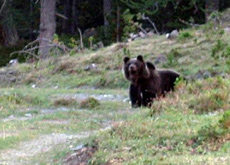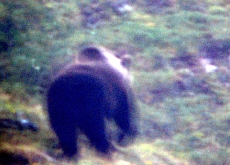Natural sanctuary welcomes humans

Heinrich Haller, head of the Swiss National Park, tells swissinfo how ecology and economy can co-exist and why he would welcome the return of bears.
Haller has run the park in eastern Switzerland for ten years and knows the 172-square-kilometre wilderness like the back of his hand.
In 1914, Switzerland led the way in creating the first national park in the Alps. It is situated near the village of Zernez, canton Graubünden.
But Swiss pioneering efforts in this field have since run out of steam and the Zernez sanctuary remains so far the only one of its kind.
In February 2004, the Swiss government disappointed many environmental organisations by ruling out the possibility of federal funding for more nature parks.
swissinfo: The Swiss National Park is the oldest in central Europe – does it still have a special status?
Heinrich Haller: Yes. Nature has been able to develop here for almost a century, since it continues to be shielded from interference. Our national park has the best protection measures anywhere in the Alps.
The concept was that an ordinary piece of alpine nature would be left to develop naturally. It is a piece of nature that doesn’t have any special sights such as canyons or geysers yet it is attractive because it hasn’t been touched.
swissinfo: What is the park’s research value?
H.H.: The Swiss National Park serves scientific research more than other parks. It has become a unique reference area for observing nature – especially over the long term.
It’s about enabling, observing and exploring the natural processes. These visionary ideas were extremely modern in 1914 and they still are today. People envy our constancy.
swissinfo: What is particularly popular among the 150,000 people who come to park every year?
H.H.: People are looking for pure nature, something that is intact and unspoilt – a wilderness that feels almost Canadian. Many come because of the large number of wild animals – red deer in particular can be observed in their natural habitat here better than almost anywhere else.
The untouched forests and flora are also a big attraction in spring and summer.
swissinfo: Since 1991 bearded vultures have been released as part of a project across the Alps. How successful has that been?
H.H.: Bearded vultures are spectacular and very well known to the public. Since 1991 24 youngsters have been released. Also, three pairs of vultures have got together – although that was in the neighbouring Stelvio National Park in Italy.
The bearded vulture is well on the way to becoming an important element of alpine fauna once again.
swissinfo: Last summer a bear appeared in the National Park and caused a sensation. Were you able to profit from that?
H.H.: The bear did result in more visitors. The Müstair Valley, where the bear was spotted several times, understood how to exploit the situation for tourists. I was happy with that, since the bear was being cast in a positive light.
The bear embodies the wilderness. One hopes that, with time, bears and other large predators can settle down once again in this region of striking natural beauty.
However, one can’t really talk about a return of bears after this one brief visit. We’ve been getting ready for the return of the brown bear for a long time – in 1997 we set up a long-term exhibition on the subject in Val S-charl, where the last bear was shot in 1904.
swissinfo: What has changed during your ten years at the park?
H.H.: We’ve restructured the park management into four areas, done a lot of public relations work and developed coordination concerning research.
We’ve also managed to integrate a small lowland plain with lakes in Macun into the National Park.
swissinfo: How do you balance the economic benefits of visitors and the protection of nature?
H.H.: Sustainability is of interest to people and nature. With nature parks there ought not to be a problem since value is placed on the protection of nature.
On the other hand, it’s always a tightrope act when you are balancing economic benefits and potential environmental consequences. Sustainability can bring economy and ecology together.
Everyone knows that short-term thinking is prevalent and often results in damage. We must resist this – especially in the Alps, which as a tourist region relies on remaining unspoilt.
swissinfo-interview: Gaby Ochsenbein, Zernez
The Swiss National Park was founded in 1914 as one of the first national parks in Europe.
Its major attractions include unequalled alpine scenery, re-introduced bearded vultures, golden eagles, chamois, deer, marmots, alpine forests and flowers.
It covers 172.3 square kilometres (0.42% of Switzerland’s surface) and has 80 km of trails.
The park creates revenue of SFr17 million ($13 million) for the tourism industry, the agriculture sector and local businesses.
Heinrich Haller was born in Muri, canton Aargau, in 1954.
He studied biology in Bern and spent many years doing field research in the National Park.
His expertise includes large predators.
He has been the head of the Swiss National Park since March 1, 1996.
He has a teaching post at Göttingen University in Germany.

In compliance with the JTI standards
More: SWI swissinfo.ch certified by the Journalism Trust Initiative












You can find an overview of ongoing debates with our journalists here . Please join us!
If you want to start a conversation about a topic raised in this article or want to report factual errors, email us at english@swissinfo.ch.